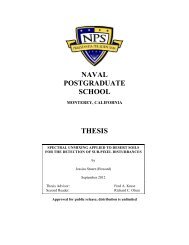October 2000 Newsletter - Naval Postgraduate School
October 2000 Newsletter - Naval Postgraduate School
October 2000 Newsletter - Naval Postgraduate School
Create successful ePaper yourself
Turn your PDF publications into a flip-book with our unique Google optimized e-Paper software.
RAD-HARD SEMICONDUCTOR CHIPS, continued from page 49<br />
was the first to measure in-situ and characterized “soft<br />
errors” during the operation of a 20 GHz circuit. The<br />
technique was first show with Hughes’ digital InGaAs<br />
Hetrojunction Bipolar technology and additional work<br />
continues with AFRL, MIT-LL and SPAWAR.<br />
(Weatherford/Fouts)<br />
• 1998 – Present: NPS has a unique relationship with<br />
Silvaco International, a Santa Clara firm that develops<br />
“Virtual Fab” software. We have the capability to simulate<br />
the IC fabrication process, electrically characterize it, and<br />
irradiate the “virtual device” in software to understand<br />
effects. It is also faster and safer than designing and<br />
performing experiments, however experiments are required<br />
to verify the computer models. Further simulation analysis<br />
can study new transistor structures or materials to increase<br />
radiation hardness. Present work supports the SPAWAR<br />
San Diego Silicon-on-Insulator Foundry, with cooperation<br />
from Dynamic Research Corporation, and Vanderbilt<br />
University. (Weatherford)<br />
• 1999 – Present: Projects with Draper Labs to study<br />
displacement damage in photodetectors for the Trident<br />
program. (Weatherford)<br />
• 1999 – Present: Projects with NSWC Crane to investigate<br />
radiation susceptibility of new generation rad-hard power<br />
transistors (Ciezki/Ashton)<br />
• 1994 – 99: Projects with NRL, SPAWAR to design lowpower<br />
logic families in GaAs IC technologies for rad-hard<br />
environments. Professor Fouts received a patent on his<br />
THE “LINAC,”continued from page 49<br />
extended to other heavy nuclei as far as lead and uranium.<br />
Almost from the beginning, the effects of radiation was<br />
investigated on various systems as diverse as semiconductors,<br />
polymers, and later, the recently discovered high temperature<br />
superconductors. The investigations of semi-conductors and<br />
devices were aimed at measuring the radiation levels causing<br />
degradation, to anticipate effects of either space radiation or<br />
nuclear detonations. The unexpected result for some high<br />
temperature superconductors was an actual enhancement of<br />
some properties after irradiation.<br />
The electron beam from the LINAC may be used to<br />
produce electromagnetic waves by various distinct mechanisms.<br />
Transition radiation occurs when the electrons pass a<br />
boundary, such as a metal or plastic foil, and this radiation<br />
occurs in the radio frequency optical and x-ray regions.<br />
RESEARCH CENTER<br />
inventions in this area. (Fouts)<br />
• 1997 – Present: Study and analysis of silicon based<br />
CMOS technologies for total dose radiation effects for<br />
proprietary NSA integrated circuits. This work has lead<br />
to new IC layout procedures and has been extended into<br />
a software tool with Lockheed-Martin to design integrated<br />
circuits for weapon environments. (Fouts)<br />
• 1995-Present – Modeling and analysis of InP, GaAs and<br />
Si solar cells for space applications, supported by both<br />
AFRL and NRL in investigating degradation in solar cells<br />
and in operational amplifiers. (Michael)<br />
Shown above are only a few research projects, many<br />
opportunities exist in this field, from the design of rad-hard<br />
circuits and systems, analysis and testing of components for<br />
present systems, to the future modeling of next generation<br />
semiconductor technologies. The organization of a<br />
multidisciplinary center at NPS in areas of electrical engineering,<br />
space systems, materials engineering, and physics to<br />
support DoD in this critical technology area should help<br />
focus continued and new support from outside the NPS<br />
while providing an important service to the strategic and<br />
space communities.<br />
Just remember next time you get upset at your laptop<br />
hanging up in a cross-country flight, or your new 1 GHz<br />
high performance desktop gets hungup, you may need to buy<br />
some rad-hard chips, not reinstall Windows©. Hopefully our<br />
future defense systems designers will be able to acquisition<br />
rad-hard parts in the future.<br />
Experiments here were aimed at soft x-ray productions from<br />
single and multiple foils.<br />
Cerenkov radiation occurs if the electrons exceed the speed<br />
of light that can only occur in a medium even air. Coherent<br />
Cerenkov radiation was observed in which the many electrons<br />
in a bunch generated by the LINAC radiate together<br />
and reinforce.<br />
Another phenomenon called parametric x-rays (PxR) was<br />
measured. Here x-rays are produced when the electron<br />
passes through a crystal. Typical crystal spacings result in 5<br />
to 10 kilovolt x-rays.<br />
Over the years the facility has been used for various<br />
projects, and oddly enough in recent years the research is<br />
going back to its roots, studying radiation effects in semiconductors<br />
for strategic systems.<br />
NPS Research page 50<br />
<strong>October</strong> <strong>2000</strong>
















